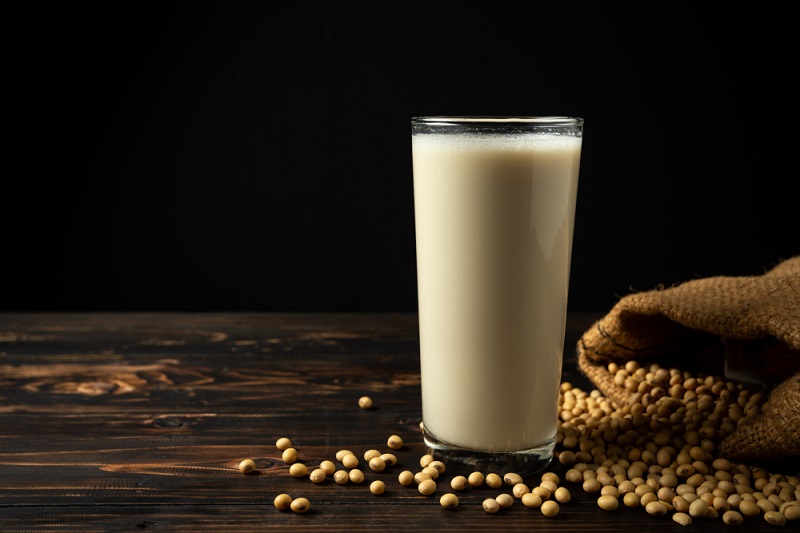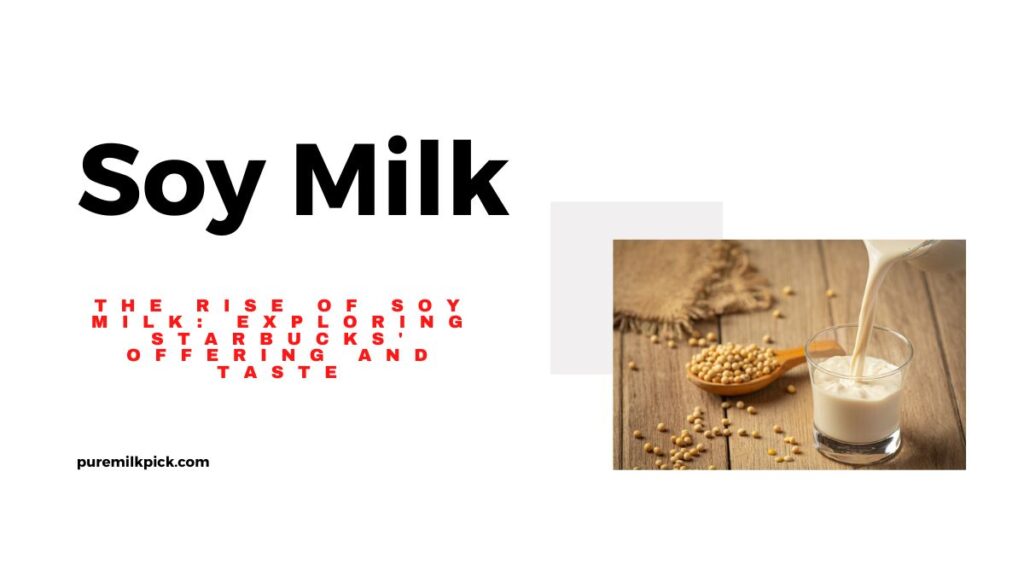Soy milk, the versatile and dairy-free elixir, has become a mainstay in the realm of plant-based milk alternatives. Beyond its incredible nutritional profile and sustainability benefits, soy milk has earned its place in countless coffee mugs, cereal bowls, and recipes across the globe. But what about its taste? Welcome to the world of soy milk’s flavor journey, where we’ll explore the diverse and delightful taste profiles, dive into its role in cooking and baking, and debunk the myths surrounding this beloved milk alternative.
The Flavor Profile of Soy Milk
Soy Milk’s Essence
Soy milk is a chameleon in the world of dairy alternatives, with a flavor profile that’s adaptable and unique. In its purest form, plain, unsweetened soy milk offers a clean, mild, and slightly nutty taste. It’s a versatile canvas, allowing the subtle characteristics of soybeans to shine without overwhelming your taste buds.
Variations in Taste
One remarkable aspect of soy milk is the diversity of tastes it offers among different brands and homemade versions. The choice of soybean variety, processing methods, and additives influences the final flavor. These variables can result in slight deviations, from a creamier texture to nuttier undertones. Exploring various brands can be an exciting journey as you discover your favorite soy milk flavor.
Compared to Other Milk Alternatives
Soy milk, like other milk alternatives such as almond and oat milk, has its own distinct taste. While almond milk is often described as nutty and mildly sweet, and oat milk boasts a creamy and oaty flavor, soy milk stands out for its slightly thicker consistency and a natural bean-like essence. It’s an excellent choice if you appreciate a neutral base that can adapt to various culinary applications.
Sweetened vs. Unsweetened Soy Milk
Sugar’s Influence on Taste
The difference between sweetened and unsweetened soy milk extends beyond sugar content. Sweetened soy milk, as the name suggests, includes added sugars, often in the form of cane sugar, brown rice syrup, or other sweeteners. This transforms the taste profile into a sweeter and more dessert-like experience.
Flavored vs. Unflavored
Flavored soy milk adds another dimension to the taste spectrum. Options like vanilla, chocolate, and strawberry infuse delightful sweet notes that can be enjoyed as stand-alone beverages or in creative recipes. Unflavored varieties are often preferred for recipes where neutrality is desired, while flavored soy milk can add an extra layer of deliciousness.
Choosing the Right Soy Milk
The right soy milk for you largely depends on your personal preferences and intended use. For a truly neutral taste that blends seamlessly into recipes, unsweetened, unflavored soy milk is the go-to choice. However, if you’re looking for a delightful sipper or a sweeter touch in your morning coffee, the sweetened and flavored varieties might be just what you crave.
Read More: Starbucks Soy Milk: Your Plant-Based Choice
Soy Milk in Cooking and Baking
Soy Milk as a Culinary Companion
Soy milk’s adaptability extends to the culinary world, making it an exceptional ingredient for both cooking and baking. It can replace dairy milk in various recipes, delivering a unique, slightly nutty taste that pairs well with sweet and savory dishes.

How Taste Changes in Recipes
When soy milk is used in recipes, its taste can undergo a transformation. In baking, it contributes to a moist and tender crumb in cakes, muffins, and cookies. Its subtle nuttiness complements the flavors of chocolate, vanilla, and spices. In savory dishes, soy milk can add a creamy texture and a mild nutty essence to soups, sauces, and mashed potatoes.
Tips for Enhancing Flavor
If you’re looking to enhance the flavor when using soy milk in recipes, consider the addition of complementary ingredients. A dash of vanilla extract can elevate the taste in desserts, while a pinch of nutmeg or herbs like thyme and rosemary can add depth to savory dishes. The key is to experiment and find the flavor combinations that suit your palate.
Common Soy Milk Varieties
Exploring Flavor Options
Soy milk is available in a variety of flavors, catering to diverse tastes and preferences. While plain, unsweetened soy milk offers a neutral base, flavored options open doors to a world of culinary creativity.
Chocolate Soy Milk
Chocolate soy milk is a delightful indulgence that combines the richness of cocoa with the mild nuttiness of soy. It’s a favorite among both kids and adults, serving as a delicious standalone beverage or as an ingredient in chocolate-centric recipes.
Vanilla Soy Milk
Vanilla soy milk infuses a touch of sweetness and warmth into your daily routine. Its vanilla essence pairs perfectly with coffee, cereals, and desserts, making it a versatile flavor to have in your pantry.

Barista Blends for Coffee
For coffee aficionados, there are specialized soy milk options, often labeled as “barista blends.” These are designed to froth and foam like dairy milk, creating the perfect canvas for latte art. The taste is neutral, ensuring that your espresso remains the star of the show.
The Impact of Processing Methods
How Processing Affects Taste
Soy milk’s taste can be significantly influenced by the processing methods used to create it. This impact is most evident when comparing homemade soy milk to store-bought alternatives.
Homemade vs. Store-Bought
Homemade soy milk tends to have a fresher and more pronounced soybean flavor. The process involves soaking, blending, and straining whole soybeans, resulting in a creamier texture and a richer taste. Store-bought options, on the other hand, may use different processing techniques, including high-temperature pasteurization, which can result in a milder flavor.
The Role of Additives
Soy milk may contain additives such as stabilizers, emulsifiers, and fortifications, which can affect its taste. Some individuals prefer pure, additive-free soy milk for a cleaner and more pronounced flavor, while others appreciate the convenience and extended shelf life offered by commercially produced varieties.
Combining Soy Milk with Other Ingredients
Creating Delicious Soy Milk-Based Beverages and Recipes
Soy milk is not limited to being a standalone beverage; it serves as an ideal base for a multitude of delicious creations. Whether you’re crafting a morning smoothie, a creamy soup, or a decadent dessert, the versatility of soy milk is your culinary canvas.
Pairing with Coffee and Tea
Soy milk’s slightly nutty taste complements the bitterness of coffee and the subtlety of tea. It’s a favored choice among plant-based and lactose-intolerant individuals. When steamed, soy milk can produce a silky microfoam perfect for latte art.

Adding to Cereals and Desserts
In your daily breakfast routine, soy milk pairs seamlessly with cereals and granola. Its neutral taste allows the flavors of your favorite cereals to shine. In desserts, soy milk is a fantastic ingredient for creamy puddings, custards, and ice creams, delivering a velvety texture and subtle nuttiness.
Nutritional Benefits and Taste
The Connection Between Nutrition and Taste
The nutritional content of soy milk is closely intertwined with its taste. Understanding the health benefits of soy milk can offer a fresh perspective on its flavor.
Soy Milk’s Health Benefits
Soy milk is renowned for its health benefits, including being a rich source of plant-based protein, essential amino acids, and heart-healthy unsaturated fats. The presence of soy isoflavones can contribute to better cardiovascular health and may have protective effects against certain chronic diseases.
Taste Perception and Dietary Preferences
The perception of soy milk’s taste is often influenced by dietary preferences and nutritional requirements. Individuals who embrace plant-based diets or face lactose intolerance find solace in soy milk’s unique flavor. Knowing that you’re nourishing your body with essential nutrients can enhance your appreciation of its taste.
Conclusion
In conclusion, the taste of soy milk is a fascinating exploration of flavors, from the mild nuttiness of plain, unsweetened varieties to the sweet allure of chocolate and vanilla. Whether you’re sipping it in your coffee, crafting delicious recipes, or enjoying it with your cereal, soy milk offers a world of taste possibilities. Embrace its versatility, and don’t be afraid to experiment with various brands and flavors to find your soy milk soulmate.
Frequently Asked Questions
Soy milk, in its unsweetened form, is not naturally sweet. Any sweetness in soy milk typically comes from added sugars in flavored varieties. Unsweetened soy milk is neutral in taste.
Yes, there can be a noticeable taste difference between store-bought and homemade soy milk. Homemade soy milk often has a fresher, creamier, and more pronounced soybean flavor, while store-bought versions may have a milder taste due to different processing methods.
Choosing the right soy milk largely depends on your personal preferences and intended use. For a neutral base in recipes, unsweetened, unflavored soy milk is ideal. If you’re seeking a sweeter or flavored taste, options like vanilla or chocolate soy milk may be more suitable.


